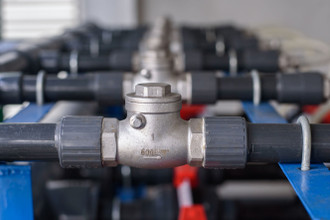What Check Valve Should I Use for my Application?
Posted by Mark Trainer on Oct 29th 2020
From industrial gas lines to household appliances, from wastewater treatment to pharmaceutical processing, from fuel pumps to air compressors, the functionality of check valves remains diverse, running the gamut through a myriad of liquid, gas, and slurry applications.
Though check valves appear in a variety of forms, the fundamental premise of these units remains similar: a typically self-operated device that opens to allow flow in one direction but closes to prevent or limit flow in the reverse direction. Initial cost, basic familiarity, required maintenance, piping orientation, and process media all prove factors that can influence the selection of a particular style of the check valve.
Exploring an array of the common types of these valves can help one begin to make an informed decision in determining the appropriate one-way valve for a specific application.
Swing Check Valves
The conventional swing check valve serves as one of the more widely recognized check valve varieties. This arrangement incorporates a circular disc whose face rests perpendicular to the flow path when in the closed position. The hinge at the top of the disc allows this flapper to swing open when the media flows in the desired direction. When flow begins to reverse in the opposite direction, the retroaction of the service media pushes against the disc forcing it closed and thus preventing further backflow.
One often finds swing check valves employed on wastewater and other liquid services. As a water check valve, the top-hinged design allows the disc to swing entirely out of the flow path of the media when in the open position, reducing turbulence and minimizing the surfaces where particulates can accumulate. Given that the nature of this design utilizes the reversal of flow to assist in the closure of the valve, such a swing check would not prove ideal in applications where the elimination of all backflow remains a priority.
Further, reliance on this backflow leaves this water check valve configuration susceptible to impacts of water hammer frequently leading to increased maintenance. Additionally, as the design needs to accommodate the rotation of the full disc out of the flow path, swing checks can grow obtrusively bulky in larger sizes.
Tilting Disc Check Valves
A tilting disc check valve modifies the traditional swing check design by eliminating the hinge at the top edge of the disc in favor of a pivot point situated with a double offset from the disc’s center. This eccentric placement of the pivot point means that, although the disc will not fully clear the flow path as in a traditional swing check, it will impede the flow-path less than a centrally placed hinge point while still allowing flow both above and below the disc when resting in the open position. This design offers several advantages including the ability of the valve to open at lower pressures.

Photo created by fanjianhua - www.freepik.com
Dual Disc Check Valves
A dual-disc check valve, also known as a double door check valve, splits the central disc into two independently functional, semicircular doors both hinged on a central pivot point. Unlike other rotationally operating checks, this dual-disc configuration allows the valve to assume a wafer type design that occupies a significantly more compact space envelope, especially in larger sizes.
Further, this design relies on spring force to keep the discs against the seat when resting in the closed position. When the upstream pressure eclipses the cracking pressure of the check valve, the doors open allowing flow to pass. However, as that upstream pressure decreases, the spring force automatically returns the doors to the closed position. This spring-assist proves significant in that it does not rely on a reversal of flow to close the valve, but rather the spring force enables the dual discs to fully seat before flow reverses.
Ball and Piston Check Valves
The traditional swing check valve, tilting disc check valve, and double door check valve all employ rotating members as the opening and closing element of the respective valve designs. Alternative configurations, such as ball checks or piston checks, have no rotational members but instead use a sealing element that lifts linearly off the seat to open the valve. Many of these lift check devices employ gravity, as opposed to a spring or flow reversal, as the force which returns the disc or ball to the seat to seal the one-way valve.
When flow proceeds in the desired direction, the force of the media itself lifts the sealing member from the seat. As the flow decreases, gravity will draw the disc or the ball back into the seated position. While these checks typically require less maintenance, gravity-assisted designs of this sort prove entirely dependent on the orientation of the check valve. Some will require installation in vertical piping with an upward flow direction. Other styles, like gravity-dependent globe style lift checks, can function only when installed in horizontal piping.
Silent and Restrictor Check Valves
In these linearly stroking configurations, the incorporation of spring as the opposing force returning the valve to the normally closed position, in lieu of reliance on gravity alone, significantly improves the versatility of their application. Having such a spring allows one to employ these checks in a variety of piping orientations and it proves an essential element in the design of both silent checks and restrictor checks.
Silent check valves, also known as non-slam valves, commonly utilize a piston with a short stroke and incorporate a spring to oppose the linear axial motion of the piston in the direction of the flow. The short-stroke and spring action allow the spring check valve to open and close quickly mitigating the shockwave effect of the water hammer and yielding the name silent check.
Alternatively, a restrictor check valve can employ a variety of different springs to manipulate the desired cracking pressure of said spring check valve so that flow will not begin until the process reaches a specified pressure. The ability to select this value of restriction leads to the name restrictor check.
Y-type check valves
Y-type check valves derive their name from the form of the construction of the valve body, which resembles that of a y-strainer except that the angled branch of the y-pattern typically rests upward upon installation. One can find this y-type design used in conjunction with a variety of dynamic sealing elements including the flapper of a swing check valve, the ball, and cone of a lift check valve, or even the spring-loaded piston of an inline check valve.
The basic utility of such a design involves the opportunity to access the dynamic sealing element of the flapper, ball, or disc, and the valve seat for routine maintenance without the necessity of having to remove the valve from the line in order to perform this service. This would not necessarily prove the case with most other check valve designs where one would typically need to shut down the process, possibly evacuate the line, and fully remove the check valve in order to access the necessary components.
Using this y-type design would prove appropriate on dirtier services where one anticipates regular cleaning owing to an accumulation of particulate or where regular maintenance schedules cannot accommodate the lengthier downtime required to fully remove an inline check valve from service in order to clean or replace worn components.
Foot Valves
Foot valves offer yet another specific adaptation of the check valve varieties. A typical foot valve utilizes an inline, linearly acting piston type check design. However, this valve style incorporates a strainer screen on the inlet side of the valve. This screen filters the service medium before it can pass through the valve and downstream in the process. This helps protect not only the valve seat from wear but more importantly helps to protect more sensitive elements of the system downstream.
Usually, one will see this style of valve installed on the feed line serving the suction side of a pump. For example, fuel pumps, whether serving an automobile or feeding industrial machinery, utilize this fashion of valve as a form of protection for the pump itself and the more delicate elements of the motor that the pump may feed. Since the valve typically resides at the bottom, or foot, of a pipe or supply line it has garnered the name foot valve. Since they serve on an array of pneumatic and hydraulic pumping applications, foot valves may face a variety of different service media with vastly different suspended particle sizes.
As such one should consider carefully both the materials of construction of the strainer elements as well as the mesh size or micron retention rate of the strainer. If the retention proves too permissive it may allow too many particles to pass thus potentially clogging or damaging the pump. If the retention of the strainer proves too fine, it may choke the flow on the suction side of the pump or require an unnecessarily high volume of maintenance or replacement. Manufacturers may offer a variety of options here to accommodate differing needs particular to specific applications.
Have an application that requires a check valve? The experts at ValveMan have the knowledge and experience to help. Shop ValveMan.com today!
Related Products
[[1480, 647, 3106]]

